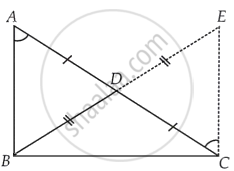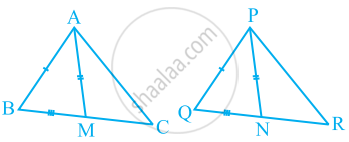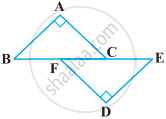Advertisements
Advertisements
प्रश्न
In a right triangle, prove that the line-segment joining the mid-point of the hypotenuse to the opposite vertex is half the hypotenuse.
उत्तर
Given: In ΔABC, ∠B = 90° and D is the mid-point of AC.
Construction: Produce BD to E such that BD = DE and join EC.
To prove: BD = `1/2` AC

Proof: In ΔADB and ΔCDE,
AD = DC ...[∵ D is mid-point of AC]
BD = DE ...[By construction]
And ∠ADB = ∠CDE ...[Vertically opposite angles]
∴ ΔADB ≅ ΔCDE ...[By SAS congruence rule]
⇒ AB = EC ...[By CPCT]
And ∠BAD = ∠DCE ...[By CPCT]
But ∠BAD and ∠DCE are alternate angles.
So, EC || AB and BC is a transversal.
∴ ∠ABC + ∠BCE = 180° ...[Cointerior angles]
⇒ 90° + ∠BCE = 180° ...[∵ ∠ABC = 90°, given]
⇒ ∠BCE = 180° – 90°
⇒ ∠BCE = 90°
In ΔABC and ΔECB,
AB = EC ...[Proved above]
BC = CB ...[Common side]
And ∠ABC = ∠ECB ...[Each 90°]
∴ ΔABC ≅ ΔECB ...[By SAS congruence rule]
⇒ AC = EB ...[By CPCT]
⇒ `1/2` EB = `1/2` AC ...[Dividing both sides by 2]
⇒ BD = `1/2` AC
Hence proved.
APPEARS IN
संबंधित प्रश्न
Two sides AB and BC and median AM of one triangle ABC are respectively equal to sides PQ and QR and median PN of ΔPQR (see the given figure). Show that:
- ΔABM ≅ ΔPQN
- ΔABC ≅ ΔPQR

BE and CF are two equal altitudes of a triangle ABC. Using RHS congruence rule, prove that the triangle ABC is isosceles.
ABC is an isosceles triangle with AB = AC. Drawn AP ⊥ BC to show that ∠B = ∠C.
In two right triangles one side an acute angle of one are equal to the corresponding side and angle of the other. Prove that the triangles are congruent.
In the following figure, BA ⊥ AC, DE ⊥ DF such that BA = DE and BF = EC. Show that ∆ABC ≅ ∆DEF.

ABC is an isosceles triangle in which AC = BC. AD and BE are respectively two altitudes to sides BC and AC. Prove that AE = BD.
Prove that sum of any two sides of a triangle is greater than twice the median with respect to the third side.
Two lines l and m intersect at the point O and P is a point on a line n passing through the point O such that P is equidistant from l and m. Prove that n is the bisector of the angle formed by l and m.
ABC is a right triangle such that AB = AC and bisector of angle C intersects the side AB at D. Prove that AC + AD = BC.
ABCD is quadrilateral such that AB = AD and CB = CD. Prove that AC is the perpendicular bisector of BD.
